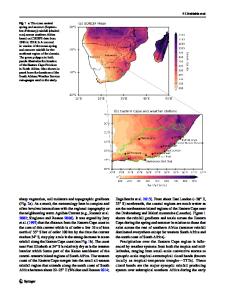The South Atlantic sub-tropical dipole mode since the last deglaciation and changes in rainfall
- PDF / 4,969,486 Bytes
- 14 Pages / 595.276 x 790.866 pts Page_size
- 47 Downloads / 285 Views
The South Atlantic sub‑tropical dipole mode since the last deglaciation and changes in rainfall Ilana Wainer1 · Luciana F. Prado2 · Myriam Khodri3 · Bette Otto‑Bliesner4 Received: 2 May 2020 / Accepted: 22 September 2020 © Springer-Verlag GmbH Germany, part of Springer Nature 2020
Abstract The South Atlantic subtropical dipole (SASD) has an impact on South American rainfall particular during its negative phase when continental precipitation in the northern part of the continent is enhanced. Relying on a series of single forcing transient simulations since the last deglaciation, we differentiate the relative role of meltwater, orbital, ice-sheets and greenhouse gases on the variability of rainfall in South America and links to the SASD. Results indicate that the meltwater forcing is the predominant driver of SASD variability. Wavelet analysis shows that most of the energy for the SASD at lower frequencies ( ∼ 5 kyr) comes from the meltwater discharge at cold events such as the Heinrich-1 cooling ∼ 17 ka and the Younger-Dryas ∼ 12.9 ka. Large rainfall changes in Northeastern Brazil can be attributed to changes in the South Atlantic sea surface temperature latitudinal gradient and South Atlantic Northward heat transport driven by the meltwater discharge. Keywords South Atlantic subtropical mode · Last deglaciation · South America
1 Introduction Significant changes in ice sheets and greenhouse gases concentration associated with changes in insolation occurred from the Last Glacial Maximum ( ∼ 22 ka) into Pre-industrial times ( ∼ 1850 Common Era (C.E.)). The warming introduced by the orbital forcing starting at LGM drove the decay of ice-sheets and ice-shelves and the influx of meltwater into the ocean. This process greatly impacted the global distribution of water and heat fluxes which was responsible for changes in the oceans and atmosphere. Of particular interest is that this period was marked by extraordinary changes in the North Atlantic where a series of abrupt cooling and warming events took place (e.g. Heinrich-1 (H1) cooling at ∼ 17 ka; Bølling–Allerød (BA) warming at ∼ 14.5 ka,
* Ilana Wainer [email protected] 1
Inst. Oceanography, University of São Paulo (IOUSP), São Paulo, Brazil
2
Inst. Geosciences, University of Brasilia, Brazil - now at IOUSP, University of São Paulo, São Paulo, Brazil
3
LOCEAN/IRD/IPSL - Sorbonne University, Paris, France
4
Climate and Global Dynamics Division, National Center for Atmospheric Research, Boulder, CO 80307, USA
warming and the cooling of the Younger–Dryas (YD) at ∼ 12.9 ka). The cooling events were associated with large input of meltwater from the retreating North Atlantic ice-sheets (He et al. 2013) while the BA warming is sometimes related to a meltwater pulse originating from Antarctica (MWP-1A, Weaver et al. (2003); Marson et al. (2014)). Many of these abrupt changes, revealed in the global and regional patterns of climate evolution, were described by Clark et al. (2012) using a compilation of surface temperature and precipitation proxy-records. Furth
Data Loading...











